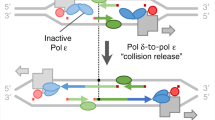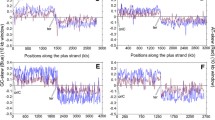Abstract
Both DNA replication and transcription are structurally asymmetric processes. An asymmetric nucleotide substitution pattern has been observed between the leading and the lagging strand, and between the coding and the noncoding strand, in eubacterial, viral, and organelle genomes. Similar studies in eukaryotes have been rare, because the origins of replication in nuclear genomes are mostly unknown and the replicons are much shorter than those of prokaryotes. To circumvent these predicaments, all possible pairs of neighboring genes that are located on different strands of nuclear DNA were selected from the complete genomes of Saccharomyces cerevisiae, Schizosaccharomyces pombe, Plasmodium falciparum, Encephalitozoon cuniculi, Arabidopsis thaliana, Caenorhabditis elegans, Drosophila melanogaster, Anopheles gambiae, Mus musculus, and Homo sapiens. For such a pair of genes, one is likely coded from the leading strand and the other from the lagging strand. By examining the introns and the fourfold degenerate sites of codons in the genes of each pair, we found that the relative frequencies of T vs. A and of G vs. C are significantly skewed in most eukaryotes studied. In a gene pair, the potential effects of replication- and transcription-associated mutation bias on strand asymmetry are in the same direction for one gene where leading strand synthesis shares the same template with transcription, while they tend to be canceled out in the other gene. Our study demonstrates that DNA replication-associated and transcription-associated mutation bias and/or selective codon usage bias may affect the strand nucleotide composition asymmetrically in eukaryotic genomes.




Similar content being viewed by others
References
MD Adams SE Celniker RA Holt et al. (2000) ArticleTitleThe genome sequence of Drosophila melanogaster. Science 287 2185–2195 Occurrence Handle10.1126/science.287.5461.2185 Occurrence Handle10731132
A Beletskii AS Bhagwat (2001) ArticleTitleTranscription-induced cytosine-to-thymine mutations are not dependent on sequence context of the target cytosine. J Bacteriol 183 6491–6493 Occurrence Handle10.1128/JB.183.21.6491-6493.2001 Occurrence Handle11591695
FR Blattner G Plunkett III CA Bloch et al. (1997) ArticleTitleThe complete genome sequence of Escherichia coli K-12. Science 277 1453–1462 Occurrence Handle1:CAS:528:DyaK2sXlvVGnu78%3D Occurrence Handle9278503
BJ Brewer WL Fangman (1993) ArticleTitleInitiation at closely spaced replication origins in a yeast chromosome. Science 262 1728–1731 Occurrence Handle8259517
M Bulmer (1991) ArticleTitleStrand symmetry of mutation-rates in the beta-globin region. J Mol Evol 33 305–310 Occurrence Handle1774785
LW Buss (1987) The evolution of individuality. Princeton University Press Princeton, NJ
IJ Fijalkowska P Jonczyk MM Tkaczyk M Bialoskorska RM Schaaper (1998) ArticleTitleUnequal fidelity of leading strand and lagging strand DNA replication on the Escherichia coli chromosome. Proc Natl Acad Sci USA 95 10020–10025 Occurrence Handle10.1073/pnas.95.17.10020 Occurrence Handle9707593
MP Francino H Ochman (2000) ArticleTitleStrand symmetry around the β-globin origin of replication in primates. Mol Biol Evol 17 416–422 Occurrence Handle10723742
MP Francino H Ochman (2001) ArticleTitleDeamination as the basis of strand-asymmetric evolution in transcribed Escherichia coli sequences. Mol Biol Evol 18 1147–1150 Occurrence Handle11371605
AC Frank JR Lobry (1999) ArticleTitleAsymmetric substitution patterns: A review of possible underlying mutational or selective mechanisms. Gene 238 65–77 Occurrence Handle10.1016/S0378-1119(99)00297-8 Occurrence Handle10570985
CM Fraser S Casjens WM Huang et al. (1997) ArticleTitleGenomic sequence of a Lyme disease spirochaete, Borrelia burgdorferi. Nature 390 580–586 Occurrence Handle1:CAS:528:DyaK2sXotVCitbs%3D Occurrence Handle9403685
LA Frederico TA Kunkel BR Shaw (1990) ArticleTitleA sensitive genetic assay for the detection of cytosine deamination: Determination of rate constants and the activation energy. Biochemistry 29 2532–2537 Occurrence Handle2185829
MJ Gardner N Hall E Fung et al. (2002) ArticleTitleGenome sequence of the human malaria parasite Plasmodium falciparum. Nature 419 498–511 Occurrence Handle10.1038/nature01097 Occurrence Handle1:CAS:528:DC%2BD38XnsFais7Y%3D Occurrence Handle12368864
D Gawel P Jonczyk M Bialoskorska RM Schaaper IJ Fijalkowska (2002) ArticleTitleAsymmetry of frameshift mutagenesis during leading and lagging-strand replication in Escherichia coli. Mutat Res 501 129–136 Occurrence Handle10.1016/S0027-5107(02)00020-9 Occurrence Handle11934444
A Gierlik M Kowalczuk P Mackiewicz MR Dudek S Cebrat (2000) ArticleTitleIs there replication-associated mutational pressure in the Saccharomyces cerevisiae genome? J Theor Biol 202 305–314 Occurrence Handle10.1006/jtbi.1999.1062 Occurrence Handle10666362
A Goffeau BG Barrell H Bussey et al. (1996) ArticleTitleLife with 6000 genes. Science 274 546–567 Occurrence Handle1:CAS:528:DyaK28XmsVWlt7k%3D Occurrence Handle8849441
D Graur W-H Li (2000) Fundamentals of molecular evolution. Sinauer Associates Sunderland, MA
P Green B Ewing W Miller et al. (2003) ArticleTitleTranscription-associated mutational asymmetry in mammalian evolution. Nature Genet 33 514–517 Occurrence Handle10.1038/ng1103 Occurrence Handle12612582
A Grigoriev (1998) ArticleTitleAnalyzing genomes with cumulative skew diagrams. Nucleic Acids Res 26 2286–2290 Occurrence Handle10.1093/nar/26.10.2286 Occurrence Handle9580676
A Grigoriev (1999) ArticleTitleStrand-specific compositional asymmetries in double-stranded DNA viruses. Virus Res 60 1–19 Occurrence Handle10.1016/S0168-1702(98)00139-7 Occurrence Handle10225270
RA Holt GM Subramanian A Halpern et al. (2002) ArticleTitleThe genome sequence of the malaria mosquito Anopheles gambiae. Science 298 129–149 Occurrence Handle10.1126/science.1076181 Occurrence Handle1:CAS:528:DC%2BD38XnsFSgsr8%3D Occurrence Handle12364791
O Hyrien K Marheineke A Goldar (2003) ArticleTitleParadoxes of eukaryotic DNA replication: MCM proteins and the random completion problem. Bioessays 25 116–125 Occurrence Handle10.1002/bies.10208 Occurrence Handle12539237
InstitutionalAuthorNameInternational Human Genome Sequencing Consortium (2001) ArticleTitleInitial sequencing and analysis of the human genome. Nature 409 860–921 Occurrence Handle1:CAS:528:DC%2BD3MXhsFCjtLc%3D Occurrence Handle11237011
S Izuta JD Roberts TA Kunkel (1995) ArticleTitleReplication error rates for G·GTP, T · GTP, and A · GTP mispairs and evidence for differential proofreading by leading and lagging strand DNA replication complexes in human cells. J Biol Chem 270 2595–2600 Occurrence Handle10.1074/jbc.270.6.2595 Occurrence Handle7852323
MD Katinka S Duprat E Cornillot et al. (2001) ArticleTitleGenome sequence and gene compaction of the eukaryote parasite Encephalitozoon cuniculi. Nature 414 450–453 Occurrence Handle10.1038/35106579 Occurrence Handle1:CAS:528:DC%2BD3MXovFamsbo%3D Occurrence Handle11719806
M Kowalczuk P Mackiewicz D Mackiewicz A Nowicka M Dudkiewicz MR Dudek S Cebrat (2001) ArticleTitleDNA asymmetry and the replicational mutational pressure. J Appl Genet 42 553–577 Occurrence Handle14564030
TA Kunkel (1992) ArticleTitleBiological asymmetries and the fidelity of eukaryotic DNA replication. Bioessays 14 303–308 Occurrence Handle1:CAS:528:DyaK38Xlt1Gnsbs%3D Occurrence Handle1637361
F Kunst N Ogasawara I Moszer et al. (1997) ArticleTitleThe complete genome sequence of the Gram-positive bacterium Bacillus subtilis. Nature 390 249–256 Occurrence Handle1:CAS:528:DyaK2sXnsVyqtrY%3D Occurrence Handle9384377
B Lewin (1997) Genes VI. Oxford University Press Oxford
JR Lobry (1995) ArticleTitleProperties of a general-model of DNA evolution under no-strand-bias conditions. J Mol Evol 40 326–330 Occurrence Handle1:CAS:528:DyaK2MXksl2gsLw%3D Occurrence Handle7723059
JR Lobry (1996a) ArticleTitleAsymmetric substitution patterns in the two DNA strands of bacteria. Mol Biol Evol 13 660–665
JR Lobry (1996b) ArticleTitleA simple vectorial representation of DNA sequences for the detection of replication origins in bacteria. Biochimie 78 323–326
JR Lobry C Lobry (1999) ArticleTitleEvolution of DNA base composition under no-strand-bias conditions when the substitution rates are not constant. Mol Biol Evol 16 719–723 Occurrence Handle10368950
MJ McLean KH Wolfe KM Devine (1998) ArticleTitleBase composition skews, replication orientation, and gene orientation in 12 prokaryote genomes. J Mol Evol 47 691–696 Occurrence Handle9847411
InstitutionalAuthorNameMouse Genome Sequencing Consortium (2002) ArticleTitleInitial sequencing and comparative analysis of the mouse genome. Nature 420 520–562 Occurrence Handle10.1038/nature01262 Occurrence Handle12466850
J Mrazek S Karlin (1998) ArticleTitleStrand compositional asymmetry in bacterial and large viral genomes. Proc Natl Acad Sci USA 95 3720–3725 Occurrence Handle10.1073/pnas.95.7.3720 Occurrence Handle9520433
M Picardeau JR Lobry BJ Hinnebusch (2000) ArticleTitleAnalyzing DNA strand compositional asymmetry to identify candidate replication origins of Borrelia burgdorferi linear and circular plasmids. Genome Res 10 1594–1604 Occurrence Handle10.1101/gr.124000 Occurrence Handle11042157
MK Raghuraman EA Winzeler D Collingwood et al. (2001) ArticleTitleReplication dynamics of the yeast genome. Science 294 115–121 Occurrence Handle1:CAS:528:DC%2BD3MXnsFyitr8%3D Occurrence Handle11588253
A Reyes C Gissi G Pesole C Saccone (1998) ArticleTitleAsymmetrical directional mutation pressure in the mitochondrial genome of mammals. Mol Biol Evol 15 957–966 Occurrence Handle9718723
EPC Rocha A Danchin (2001) ArticleTitleOngoing evolution of strand composition in bacterial genomes. Mol Biol Evol 18 1789–1799 Occurrence Handle11504858
EPC Rocha A Danchin A Viari (1999) ArticleTitleUniversal replication biases in bacteria. Mol Microbiol 32 11–16 Occurrence Handle10.1046/j.1365-2958.1999.01334.x Occurrence Handle10216855
C Shioiri N Takahata (2001) ArticleTitleSkew of mononucleotide frequencies, relative abundance of dinucleotides, and DNA strand asymmetry. J Mol Evol 53 364–376 Occurrence Handle10.1007/s002390010226 Occurrence Handle11675596
N Sueoka (1995) ArticleTitleIntrastrand parity rules of DNA-base composition and usage biases of synonymous codons. J Mol Evol 40 318–325 Occurrence Handle1:CAS:528:DyaK2MXksl2gsL8%3D Occurrence Handle7723058
InstitutionalAuthorNameThe Arabidopsis Genome Initiative (2000) ArticleTitleAnalysis of the genome sequence of the flowering plant Arabidopsis thaliana. Nature 408 796–815 Occurrence Handle11130711
InstitutionalAuthorNameThe C. elegans Sequencing Consortium (1998) ArticleTitleGenome sequence of the nematode C. elegans: A platform for investigating biology. Science 282 2012–2018 Occurrence Handle9851916
ERM Tillier RA Collins (2000) ArticleTitleThe contributions of replication orientation, gene direction, and signal sequences to base-composition asymmetries in bacterial genomes. J Mol Evol 50 249–257 Occurrence Handle10754068
V Wood R Gwilliam MA Rajandream et al. (2002) ArticleTitleThe genome sequence of Schizosaccharomyces pombe. Nature 415 871–880 Occurrence Handle1:CAS:528:DC%2BD38Xhs1ygtbk%3D Occurrence Handle11859360
CI Wu N Maeda (1987) ArticleTitleInequality in mutation-rates of the 2 strands of DNA. Nature 327 169–170 Occurrence Handle1:CAS:528:DyaL2sXktlGhtr8%3D Occurrence Handle3574477
JJ Wyrick JG Aparicio T Chen JD Barnett EG Jennings RA Young SP Bell OM Aparicio (2001) ArticleTitleGenome-wide distribution of ORC and MCM proteins in S. cerevisiae: High-resolution mapping of replication origins. Science 294 2357–2360 Occurrence Handle1:CAS:528:DC%2BD3MXptFGrtbw%3D Occurrence Handle11743203
A Zawilak S Cebrat P Mackiewicz A Krol-Hulewicz D Jakimowicz W Messer G Gosciniak J Zakrzewska-Czerwinska (2001) ArticleTitleIdentification of a putative chromosomal replication origin from Helicobacter pylori and its interaction with the initiator protein DnaA. Nucleic Acids Res 29 2251–2259 Occurrence Handle10.1093/nar/29.11.2251 Occurrence Handle11376143
Acknowledgements
We thank Dr. O. Hyrien for kindly sending us a preprint before publication and the anonymous referees for their helpful comments. The research was supported by the NSFC (Grants 30270695, 30240026, and 30125008) and China Postdoctoral Science Foundation.
Author information
Authors and Affiliations
Corresponding author
Rights and permissions
About this article
Cite this article
Niu, D.K., Lin, K. & Zhang, DY. Strand Compositional Asymmetries of Nuclear DNA in Eukaryotes . J Mol Evol 57, 325–334 (2003). https://doi.org/10.1007/s00239-003-2483-9
Received:
Accepted:
Issue Date:
DOI: https://doi.org/10.1007/s00239-003-2483-9




